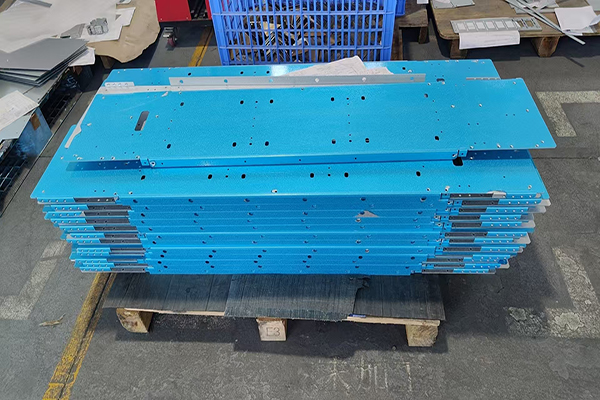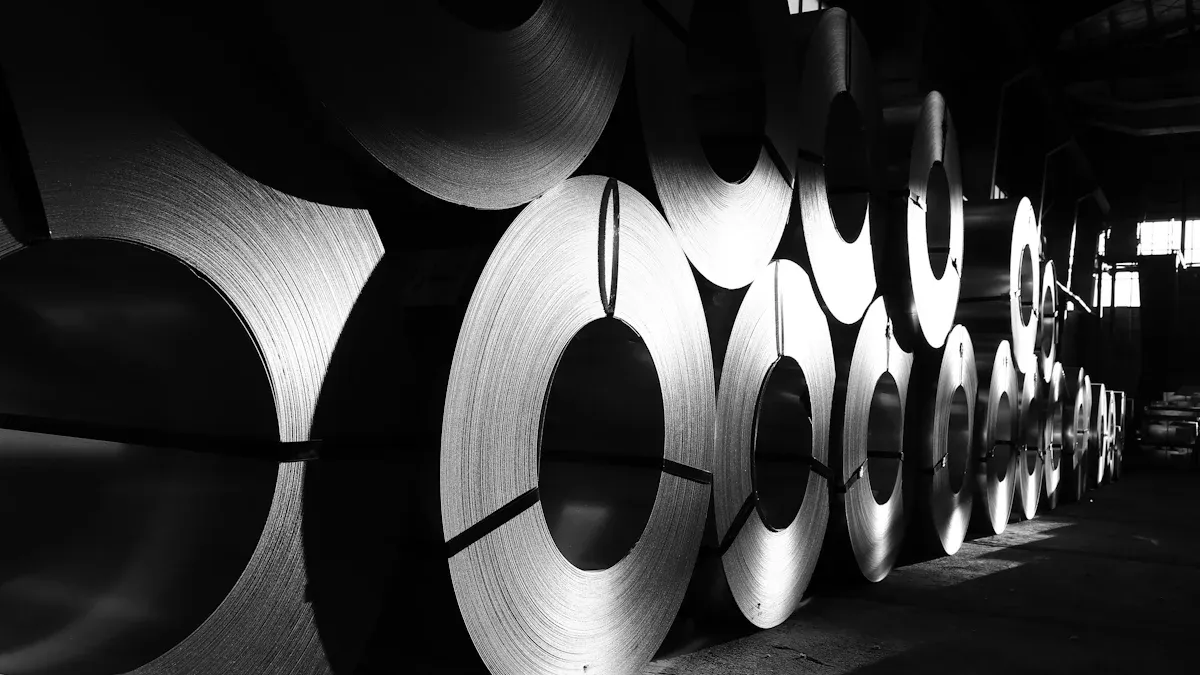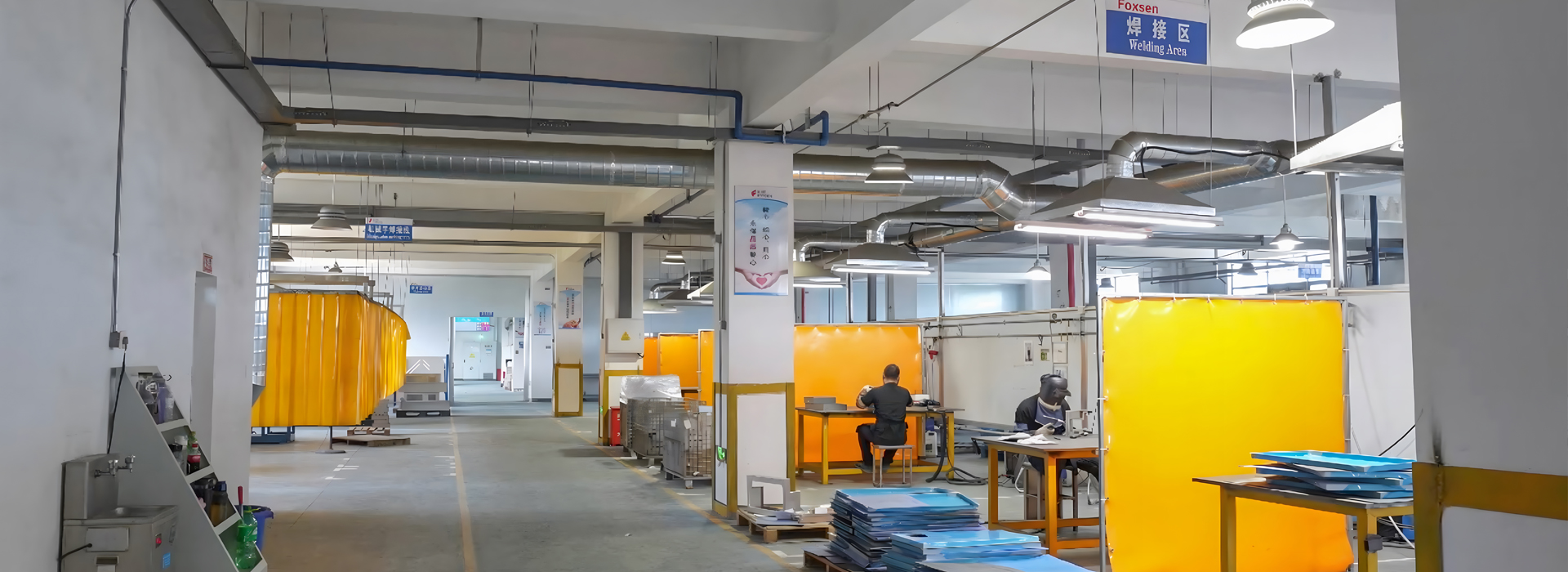
Choosing the right sheet metal depends on your project needs. Each type—aluminum, steel, and brass—has special qualities. Aluminum is light, so it’s great for jobs needing less weight. Steel is strong and heavy, making it good for tough tasks. Brass is durable and looks nice, perfect for decorations. Aluminum is stronger for its weight than steel, with a 2.8:1 ratio. These features make each metal best for certain uses, like building, cars, or art.
Key Takeaways
Aluminum is light and resists rust, good for cars and planes.
Steel is tough and useful, great for building and machines.
Brass is strong and looks nice, perfect for decorations and instruments.
Think about weight, strength, and looks to pick the right metal.
Recycling steel helps the planet by saving energy and cutting waste.
Overview of Sheet Metal Materials
Aluminum: Lightweight and Corrosion-Resistant
Aluminum is light and doesn’t rust easily. It’s great for projects needing less weight, like cars or planes. After anodizing, aluminum resists rust even better. This process adds a stronger protective layer. Tests show aluminum handles extreme temperatures well, from −100°C to 300°C. It’s also easy to cut, bend, and shape, making it useful in factories. Aluminum comes in different types, like 6061 and 5052, for various jobs. Whether you need strength or flexibility, aluminum works well.
Steel: Strong and Versatile
Steel is strong and can be used in many ways. It’s perfect for heavy machines and building structures. Steel grades like ST52 are great for tough tasks. Tests measure steel’s strength and ability to stretch without breaking. Steel comes in types like stainless steel and high-strength alloys. Some resist rust, while others are extra durable. Steel can be recycled, which helps the environment.
Brass: Decorative and Durable
Brass looks nice and lasts a long time. It’s often used in home décor, musical instruments, and buildings. Brass is easy to shape and machine, making it popular for designs. Lead-free brass is better for the environment. Brass doesn’t rust much, even in tough conditions like salty air. Special coatings, like PVD, make brass stronger and shinier. Brass is a great choice for things that need to look good and last.
Comparing Key Properties of Metal Sheets

Weight: Lightweight vs. Heavy Materials
Weight is important when picking sheet metal. Aluminum is the lightest of the three. Its low weight makes it great for planes and cars. Steel is much heavier but very strong. This makes it good for tough jobs, but not for projects needing less weight. Brass is in the middle. It’s heavier than aluminum but lighter than steel. This balance makes it useful for decorations and structures.
Aluminum is light but still strong. This is why it’s popular for jobs needing both strength and low weight. Steel is heavier but super tough, so it’s used in buildings and machines. Brass has medium weight and looks nice, making it good for stylish and lasting designs.
Strength: High Strength vs. Flexibility
Strength is another big factor for sheet metal. Steel is very strong and great for heavy-duty work. Aluminum isn’t as strong as steel but has a good strength-to-weight ratio. It can handle stress without being heavy. Brass isn’t as strong as steel or aluminum but is durable and flexible, perfect for decorations.
Here’s a table showing how materials balance strength and flexibility:
The table shows how materials compare in strength and flexibility. Steel, like spring steel, is very strong but less flexible. Aluminum alloys, such as DS-STG, are strong and more flexible. Brass isn’t listed but is chosen for its easy shaping and medium strength.
Workability: Ease of Sheet Metal Work
Workability means how easy it is to shape or cut metal. Aluminum is very easy to work with. It’s light and flexible, so it doesn’t need special tools. Aluminum bends well, which is why it’s used in cars and planes.
Steel is harder to shape because it’s stiff. But with the right tools, it can be worked on. Brass is very easy to cut and shape. It’s great for detailed designs and decorations.
Here’s a quick summary of workability:
Aluminum is light and easy to shape. No special tools are needed.
Steel is strong but harder to work with. Special tools help.
Brass is durable and easy to machine, perfect for fancy designs.
Each metal has its own strengths. Aluminum is best for quick shaping. Steel is for tough jobs. Brass is ideal for artistic and decorative projects.
Corrosion Resistance: Long-Term Durability
How well metal resists rust affects how long it lasts. Aluminum is great at this because it forms a natural shield. This layer stops rust from forming. Anodizing makes the shield even stronger. That’s why aluminum is perfect for outdoor or wet places. For example, it’s used in boats since it doesn’t rust in saltwater.
Steel can rust unless it’s treated. Galvanized steel has a zinc coating that helps stop rust. It’s often used for roofs and outdoor buildings. Stainless steel has chromium, which creates a rust-proof layer. This makes it great for kitchens and medical tools since it handles moisture well.
Brass also fights rust well. It doesn’t rust like steel and doesn’t tarnish easily. This makes it great for decorations. Brass is often used near the ocean because salty air doesn’t harm it much. It stays strong even in tough conditions.
When picking metal, think about where it will be used. For wet or salty places, aluminum or brass is best. If you need strength too, choose galvanized or stainless steel.
Cost: Affordable vs. Premium Options
Price is important when choosing metal sheets. Aluminum costs more than steel but resists rust better and is lighter. This makes it worth the price for planes and cars, where performance matters.
Steel is cheaper, especially basic types. Galvanized steel costs a bit more because of its zinc coating but is still affordable for building projects. Stainless steel is pricier because it’s tougher and resists rust better.
Brass costs the most of the three. Its shiny look and rust resistance make it a luxury choice. It’s often used in fancy designs and high-end items where looks are key.
Here’s a table showing cost factors:
When I think about cost, I look at the budget and value. Steel is best for saving money, aluminum for performance, and brass for luxury.
Head-to-Head Comparisons of Sheet Metals
Aluminum vs. Steel: Weight and Strength
Aluminum and steel differ in weight and strength. Aluminum is much lighter than steel. Its density is about 2.70 g/cm³, while steel’s is 7.85 g/cm³. This makes aluminum great for planes and cars, where less weight helps. Steel is much stronger than aluminum. Its tensile strength is 400–500 MPa, compared to aluminum’s 90 MPa.
Steel also has higher yield strength. Steel’s yield strength is 250 MPa, while aluminum’s is only 40 MPa. This makes steel better for heavy-duty jobs like building and machines. But aluminum’s strength-to-weight ratio is impressive. It works well when both strength and low weight are needed.
Here’s a simple comparison:
Aluminum is best for light designs. Steel is better for strong, tough projects.
Steel vs. Brass: Durability and Aesthetic Appeal
Steel and brass are good for different things. Steel is very strong and lasts a long time. It’s perfect for buildings and machines. Brass looks nice and is easy to shape. It’s great for decorations like home items and musical instruments.
Brass resists rust well, even in salty or wet places. Steel’s rust resistance depends on its type. Stainless steel doesn’t rust easily, but untreated steel can rust quickly.
If you need something strong and pretty, choose brass. For strength and durability, steel is the better pick.
Aluminum vs. Brass: Corrosion Resistance and Cost
Aluminum and brass both resist rust, but in different ways. Brass is great for plumbing and ocean areas because it handles saltwater well. Aluminum naturally resists rust but needs anodizing for tough conditions.
Cost is another difference. Aluminum is cheaper because it’s easy to make and widely available. Brass costs more because it’s heavier and less common. Its higher price is worth it for its beauty and durability.
For big projects where saving money matters, aluminum is the best choice. Brass is better for fancy designs and places needing extra rust resistance.
Best Sheet Metal for Specific Applications
Construction: Strength and Longevity
In construction, picking the right metal is very important. Steel is the top choice because it’s super strong and lasts long. Strong steel types, like ST52, are often used in buildings and bridges. These metals make structures sturdy and reliable.
Tip: Steel can be recycled, making it better for the planet.
A study called The role of concrete compressive strength on the service life and life cycle of an RC structure shows why strong materials matter. It explains how steel helps reinforced concrete last longer.
For roofs and walls, aluminum is a lighter option. It doesn’t rust easily, so it’s great for outdoor use. Brass isn’t used much for building but adds style to things like railings and fixtures.
Automotive: Lightweight and Performance
In cars, lightweight metals improve fuel use and safety. Aluminum is a favorite here. Its light weight makes cars more fuel-efficient and lowers pollution. Many car makers now use aluminum for frames and panels.
Here’s a table comparing lightweight materials for cars:
Steel is still used for parts needing extra strength, like the chassis. It’s strong enough to keep people safe in crashes. Brass isn’t common in car parts but is used for trims because it looks nice.
Here are some key terms for car metals:
These terms show why aluminum is great for cars. It’s strong but easy to shape, making it a top pick.
Decorative Uses: Aesthetic and Corrosion Resistance
For decorations, metals need to look good and last long. Brass is perfect for this. Its shiny gold color makes it popular for home décor, instruments, and accents. Brass also resists rust, even in salty air.
Here’s a table showing how metals compare for looks and rust resistance:
Decorative metals are useful for both art and function. They can handle high heat without damage. Aluminum is light and rust-resistant, making it great for modern designs. Stainless steel has a shiny, polished look, perfect for kitchens and appliances.
Note: Metals like brass and copper add luxury, while aluminum and stainless steel are practical and stylish.
When picking metals for decorations, think about the design and where it will be used. Brass and copper are great for artistic projects. Aluminum and stainless steel are better for durable, modern designs.
When picking sheet metal, think about your project’s needs. Aluminum is light and doesn’t rust easily, making it great for many uses. Steel is super strong and works well for tough jobs. Brass is both strong and pretty, perfect for decorations. Each metal has its own strengths. Decide what matters most—weight, strength, or looks—to choose the best one. Picking the right metal helps your project last longer and work better.
FAQ
What is the best sheet metal for outdoor use?
Aluminum is great for outdoor projects. It doesn’t rust and lasts long in wet places. Brass is also good for outdoor decorations. It handles salty air well.
Can I use brass for structural applications?
Brass isn’t strong enough for big structures. It’s better for decorations or small items. Steel is the strongest choice for building and heavy-duty work.
How does aluminum compare to copper sheet for corrosion resistance?
Aluminum fights rust better than copper in most places. Copper forms a patina that protects it but changes its look. Aluminum stays light and rust-free, making it more useful.
Is steel recyclable?
Yes, steel can be recycled easily. Recycling steel helps the planet by saving energy and reducing waste. It’s a smart choice for eco-friendly projects.
Which metal is easiest to shape?
Brass is very easy to shape. It’s soft and great for detailed designs. Aluminum is also simple to work with, especially for light jobs. Steel is harder to shape and needs special tools.





